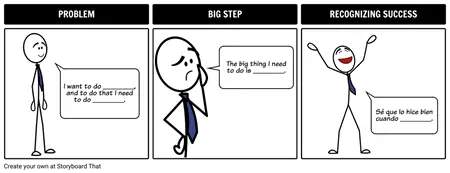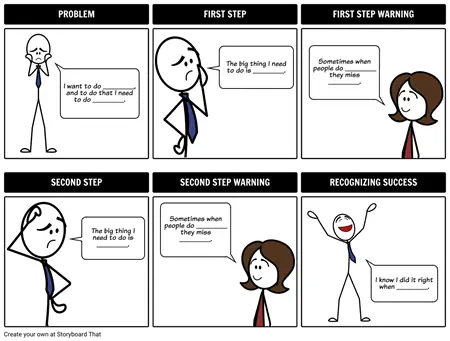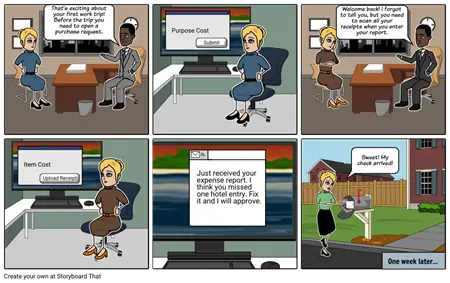Effective Framework Templates for Visual Storytelling Processes

Work and life are full of processes, and as a general rule, people don't like reading long, boring checklists. Process storyboards are a helpful way to educate people and to look for opportunities to reduce steps. The framework for process explanations is Problem– Steps – Success
- Problem: What are the common needs for this process?
- Steps: What are the big key steps?
- Success: How do you know when it worked?
Storyboard Examples
How Tos about How to Explain a Process with a Storyboard
Maximize Student Engagement Using Visual Storytelling in Daily Lessons
Visual storytelling can make lessons more interactive and memorable. Integrating storyboards into your teaching helps students grasp complex ideas and enjoy the learning process.
Select a Topic That Benefits from Visualization
Choose a lesson or concept where visual aids can clarify steps, such as scientific processes or historical events. This ensures students see the ‘big picture’ and understand key moments.
Break Down the Topic into Simple Steps
Identify the main stages or actions in your topic. Keep each step clear and concise so students can easily follow and illustrate them on their storyboard.
Assign Students to Create Their Own Storyboards
Have students sketch or use online tools to build storyboards for the process. Encourage creativity and let them add captions, drawings, or dialogue to explain each step.
Review and Discuss Student Storyboards as a Class
Share and analyze different storyboards together. Highlight effective visuals and storytelling to reinforce understanding and allow peer feedback.
Frequently Asked Questions about How to Explain a Process with a Storyboard
What is a process storyboard and how can it help K-12 teachers?
A process storyboard is a visual tool that breaks down complex procedures into clear, illustrated steps. For K-12 teachers, it helps simplify lesson planning, engage students, and clarify instructions, making learning more interactive and effective.
How do I use the Problem–Steps–Success framework for teaching?
To use the Problem–Steps–Success framework, start by identifying the main challenge (Problem), outline the essential actions (Steps), and define what successful completion looks like (Success). This structure fosters clearer communication and better student understanding.
What are some examples of visual storytelling in lesson plans?
Visual storytelling in lesson plans can include storyboards for science experiments, illustrated math problem solving, or comic strips depicting historical events. These methods help students visualize concepts and retain information more effectively.
Why is visual storytelling effective for explaining classroom processes?
Visual storytelling supports different learning styles, makes complex processes easier to grasp, and increases student engagement. By turning steps into images, teachers can reduce confusion and make lessons more memorable.
What are the best templates for creating process storyboards?
The best templates for process storyboards are those that follow a clear structure, such as Problem–Steps–Success. Templates with customizable panels, icons, and text boxes help teachers quickly adapt visuals to any subject or lesson.
© 2025 - Clever Prototypes, LLC - All rights reserved.
StoryboardThat is a trademark of Clever Prototypes, LLC, and Registered in U.S. Patent and Trademark Office



